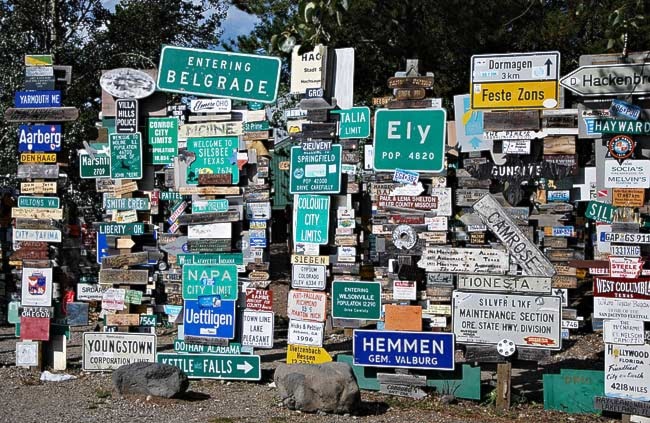Everybody has their own stories about cold weather driving in the North.
When I first moved north, to start a permanent job in Dawson City. I was about 80 kilometres away from the community when a rock must have hit my radiator, causing it to leak. The antifreeze drained out and my truck overheated and I was stranded.
Being an ingenious lad, I waded through the snow and foraged for deadwood in the brush beside the highway. I built a fire, and, using a cooking pot from the load of goods in the back of my pick-up, I melted snow.
Eventually, I filled the radiator with water. I stuck chewing gum over the hole in the rad and drove to the Dempster Highway Lodge, where I purchased more chewing gum for the final leg. As long as I kept moving, the cold air kept the gum firmly in place. If I stopped, the gum would sizzle and bubble away and I would have to chew up another patch.
Some of my driving episodes were not so pleasant - like the time I drove back to Dawson with my wife and mother-in-law when it was -55C. It impressed upon me how important transportation is to commerce and daily life and how we take it for granted until the mercury hides in the bulb at the bottom of the thermometer.
In the early days, when transportation to Dawson was even more difficult, the strategy for provisioning for winter was to stockpile, in the fall, all the supplies that would be needed. Basements were filled with canned goods, preserves and local food. Christmas presents were ordered in August or September.
Today, with all-weather roads, the stream of supplies continues uninterrupted except for the occasional super-cold spells or blizzard. The stock on the shelves becomes sparse for a few days, but generally we take the ease and convenience of our supply of goods for granted. We shouldn’t.
Two of the strategies for hauling supplies during the 1950s were Cat trains and snow monsters.
I spoke with John Gould about this a few years ago. Back in the 1950s, he worked on the Cat trains in the winter. These convoys operated north of Dawson for a few years while oil exploration was being conducted on the Eagle Plains. Bulk goods like fuel, construction materials and pipe could only economically be supplied to the drill sites by Cat trains overland in winter when the soft, mushy tundra froze solid and was covered with a blanket of snow.
Caterpillar tractors pulled strings of sleds carrying essential supplies. They worked in groups because there was safety in numbers.
They carried with them tiny, portable kitchen/bunkhouses in which the men could sleep and eat. They worked in shifts so that the trains moved forward 24 hours a day. While one crew operated the equipment, the other slept, even while the convoy moved forward.
The conditions were harsh. In addition to the cold, they had to contend with long hours of darkness, wind and isolation. If equipment broke down, it had to be repaired on the spot. John showed me photos of day the lead tractor of the train went through the ice on the Blackstone River. It broke one of its tracks. Pulling the machine out of the hole in the ice and welding the damaged track took them all of a long cold day.
Another, and perhaps the most remarkable, device ever constructed to haul freight into the remote regions of the North was the Letourneau snow train. Vermont-born Robert G. Letourneau was known as the Dean of Earthmoving. With hundreds of patents for graders, scrapers and bulldozers, Letourneau built heavy earth-moving equipment - big earthmoving equipment. Letourneau also built the first off-shore oil drilling rigs.
The Letourneau Logistical Cargo Carrier (LCC-1), which operated in the Yukon and Alaska, consisted of a lead car and three trailers. The massive units ran on 16 tires almost five metres high. The carrier was powered by a single 600-hp Cummins diesel engine, which supplied the juice for the electric drive units on each of the wheels. Because of its size, local residents have long referred to this machine as the “snow monster.”
Built in 1955, this remarkable contraption hauled up to 45 tonnes of cargo to DEW line stations along the northern rim of Alaska until 1961, when it was replaced by other methods of transport. One of these units, consisting of the lead tractor unit and two of the three trailers, lay unused for years near Fairbanks until an anonymous Whitehorse benefactor recently acquired the equipment, which was destined for a museum in Alberta. It will reside at the Yukon Transportation Museum for the next three years.
The massive drive unit and trailers were carefully set up in front of the museum using large cranes, just before Christmas. With the installation of the huge balloon tires on the axles, this unique “snow monster” now truly lives up to its name.
The museum plans to use the equipment for research and interpretive purposes, including youth programming, during its stay at the museum. It will be a great advertisement for the museum and a powerful reminder of the importance of winter transportation for northern resource development and national defence during the Cold War era.
Michael Gates is a Yukon historian and sometimes adventurer based in Whitehorse. His book, History Hunting in the Yukon, is now available. You can contact him at msgates@northwestel.net
